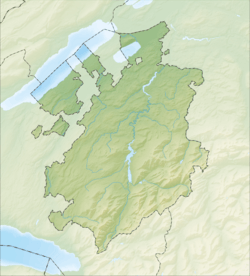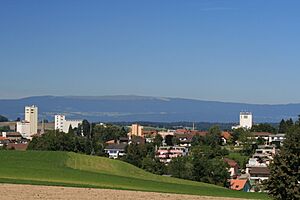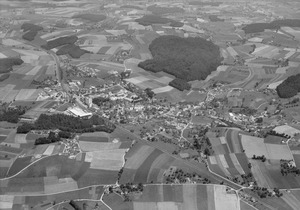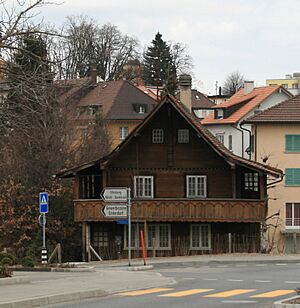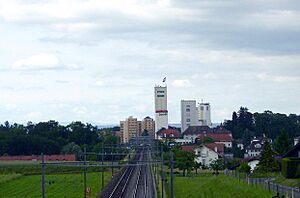Düdingen facts for kids
Quick facts for kids
Düdingen
|
||
|---|---|---|
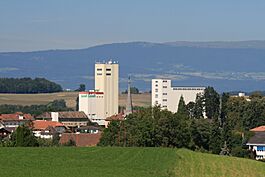
Düdingen
|
||
|
||
| Country | Switzerland | |
| Canton | Fribourg | |
| District | Sense | |
| Area | ||
| • Total | 30.76 km2 (11.88 sq mi) | |
| Elevation | 596 m (1,955 ft) | |
| Population
(Dec 2020 )
|
||
| • Total | 8,300 | |
| • Density | 269.8/km2 (699/sq mi) | |
| Postal code |
3186
|
|
| Surrounded by | Barberêche, Bösingen, Fribourg (Freiburg im Üechtland/Fribourg), Granges-Paccot, Gurmels, Kleinbösingen, La Sonnaz, Schmitten, Tafers | |
Düdingen is a town in Switzerland. It is located in the Sense district of the Fribourg canton. Düdingen is special because most of its people speak German. This is interesting because the Fribourg canton mostly speaks French.
Contents
History of Düdingen
Düdingen is an old town. It was first written about in the year 1180. Back then, it was called Doens. Later, in 1258, its name was Tiudingen. By 1414, people called it Dyung.
Geography of Düdingen
Düdingen covers an area of about 30.86 square kilometers (11.92 square miles). A large part of this land, about 67.5%, is used for farming. This means farmers grow crops or raise animals there. About 13.3% of the land is covered by forests.
Around 12.4% of Düdingen is built up with buildings and roads. Rivers and lakes make up about 6.3% of the area. A very small part, 0.6%, is land that cannot be used for anything.
Düdingen is located north of the city of Fribourg. It is the town with the most people in the Sense district. Düdingen is made up of several smaller villages or hamlets. Some of these are Mariahilf, Schiffenen, Bonn, and Jetschwil.
What is the Coat of Arms of Düdingen?
A coat of arms is like a special symbol for a town or family. Düdingen's coat of arms shows a golden ox skull on a silver background. Above it, there's a red stripe with three white roses.
People and Population in Düdingen
Düdingen has a population of about 8,700 people (as of 2023). About 9.7% of the people living there are from other countries. Over the past 10 years, the number of people living in Düdingen has grown by about 8.6%.
Most people in Düdingen speak German. About 89.7% of the population speaks German as their main language. The second most common language is French, spoken by about 4.5% of the people. Some people also speak Serbo-Croatian or Italian.
In 2008, about half of the population was male (49.8%) and half was female (50.2%). Many people living in Düdingen were also born there. About 41.5% of the people in 2000 were born in Düdingen.
Most people in Düdingen are adults. About 64.3% of the population is between 20 and 64 years old. Children and teenagers (0-19 years old) make up 23.8% of the population. Older people (over 64 years old) make up 11.9%.
Important Heritage Sites
Düdingen has several important historical places. These are called heritage sites of national significance. They are protected because they are very important to Switzerland's history and culture.
Some of these sites include:
- A farm house at Galmis 6.
- The old hermitage of St. Magdalena. A hermitage is a place where a religious person lives alone.
- The Grandfey-Viadukt, which is a large bridge shared with the town of Granges-Paccot.
- Two old country manors, the de Boccard and von Montenach estates.
- Two pilgrimage chapels: one at St. Wolfgang 25 and another called Muttergottes. Pilgrimage chapels are special places where people go for religious journeys.
Also, the entire small villages of Jetschwil and Galmis are part of the Inventory of Swiss Heritage Sites. This means they are special and protected areas.
-
Grandfey-Viadukt (shared with Granges-Paccot)
Economy and Jobs in Düdingen
In 2010, the unemployment rate in Düdingen was low, at 1.9%. This means most people who wanted jobs had them. Many people work in different types of jobs.
- Agriculture: About 243 people work in farming. This is called the primary economic sector.
- Industry: Around 1,213 people work in factories or construction. This is the secondary sector. Many of these jobs are in manufacturing, making things.
- Services: The largest number of people, 1,687, work in the tertiary sector. This includes jobs like sales, transportation, hotels, restaurants, and healthcare.
Many people who live in Düdingen also work there. However, more people travel out of Düdingen for work than come into it. About 60.6% of working people use a private car to get to their jobs. About 16.1% use public transportation.
Religion in Düdingen
Most people in Düdingen are Christian. In 2000, about 72.4% of the population were Roman Catholic. Another 15.2% belonged to the Evangelical Reformed Church of the Canton Freiburg.
Some people also belonged to other Christian churches, like Orthodox or Christian Catholic. About 3.08% of the population was Islamic. A small number of people were Buddhist or Hindu. About 3.43% of the people said they did not belong to any church.
Education in Düdingen
The school system in Fribourg canton, where Düdingen is located, has several levels.
- Kindergarten: Children can go to one year of kindergarten, which is not required.
- Primary School: After kindergarten, there are six years of primary school.
- Lower Secondary School: Then, students go to three years of required lower secondary school. Here, students are grouped based on their skills.
- Upper Secondary School: After that, students can choose to go to an optional three or four-year upper secondary school. This can be a gymnasium (which prepares them for university) or a vocational program (which teaches job skills).
- Tertiary School: After upper secondary, students can go to a university or continue their training for a specific job.
In the 2010-2011 school year, over 1,000 students attended schools in Düdingen. There were classes for kindergarten, primary, and lower secondary students. Some students from Düdingen also went to schools in other towns for upper secondary education.
Transportation in Düdingen
Düdingen has its own railway station, called Düdingen. This station is on the Lausanne–Bern line. You can take trains from Düdingen to cities like Bern, Bulle, Fribourg/Freiburg, and Thun.
Sport in Düdingen
Düdingen has a football (soccer) club called SC Düdingen. They play in the Swiss 1. Liga, which is the third highest level of football in Switzerland.
Culture in Düdingen
Every year, a music festival called Bad Bonn Kilbi takes place in Düdingen. It usually happens in the last week of May.
See also
 In Spanish: Düdingen para niños
In Spanish: Düdingen para niños




